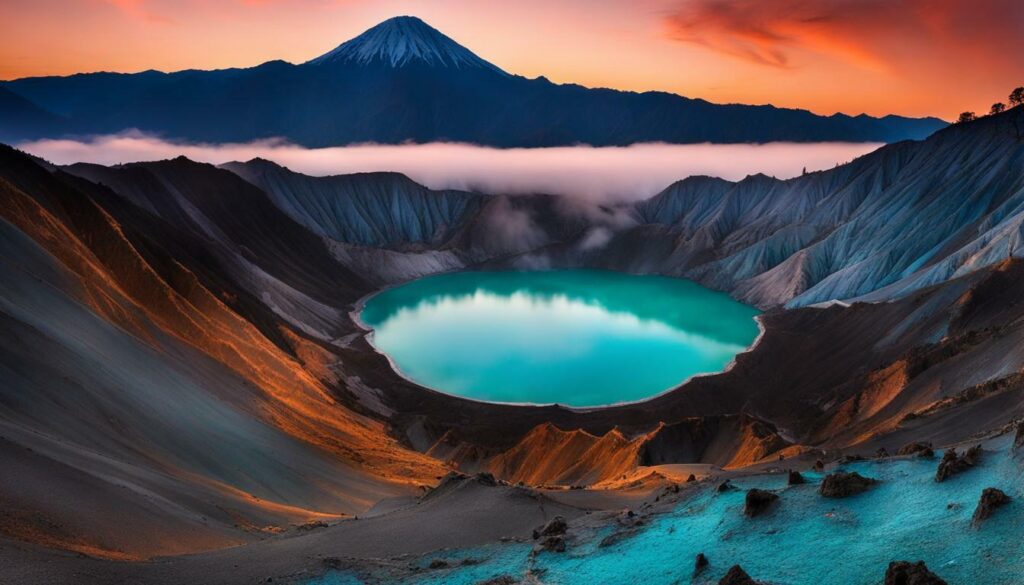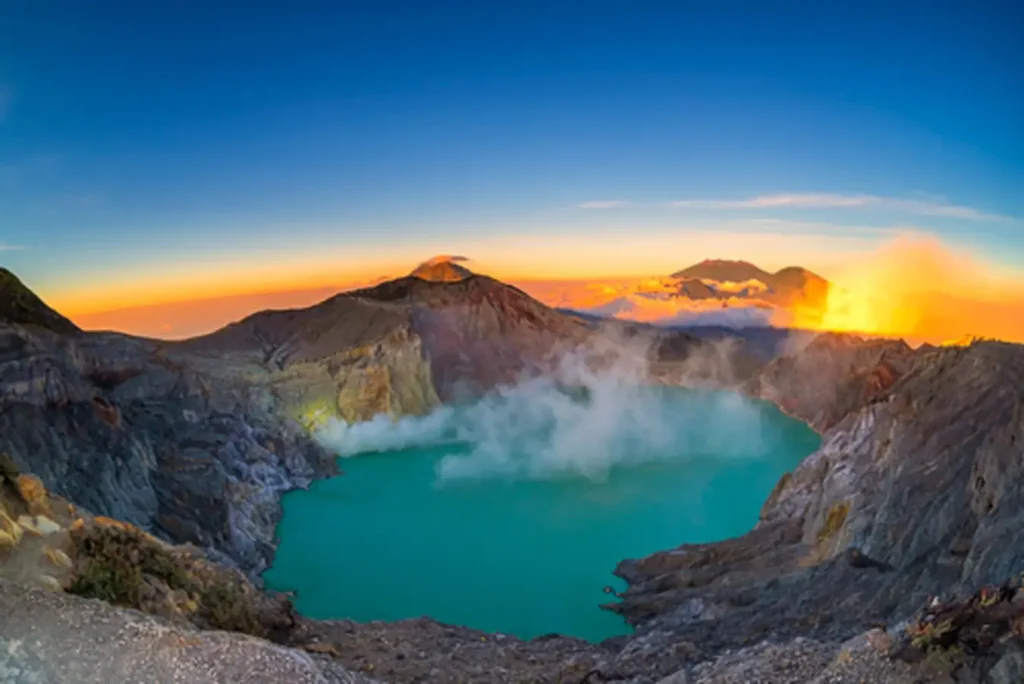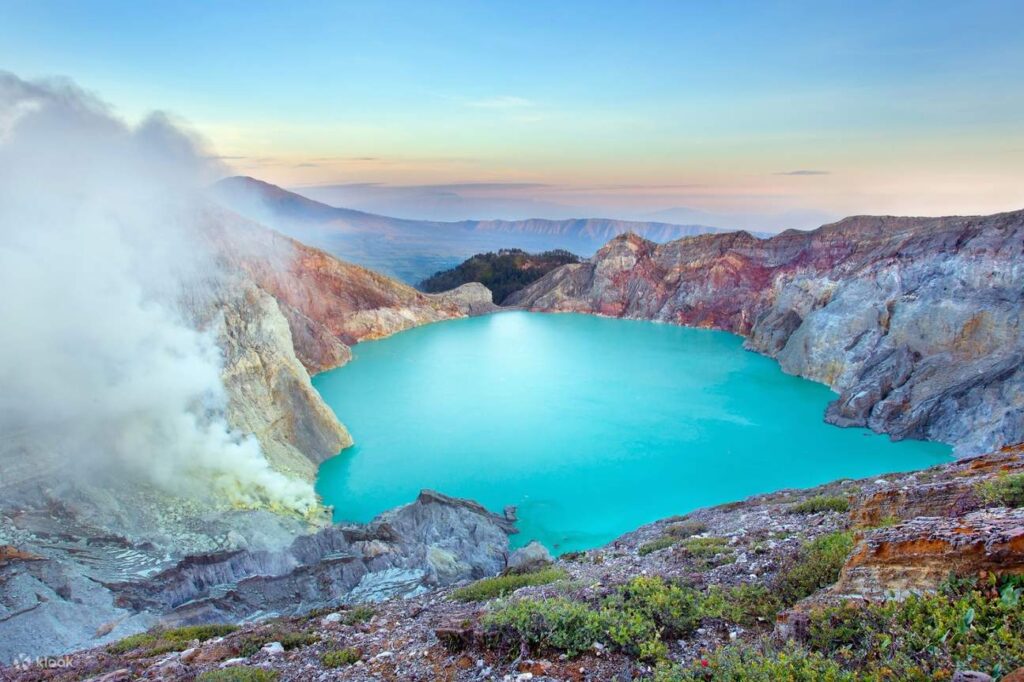Indonesia is home to some of the most breathtaking natural wonders in the world, and one of them is Mountain Ijen. Located in East Java, this stunning mountain range is a popular destination for adventurers and nature enthusiasts alike. Whether you’re looking to hike to the top of a volcano, witness mesmerizing blue fire, or simply soak in the breathtaking views, Mountain Ijen has something for everyone.
One of the most famous attractions of Mountain Ijen is the Ijen crater, a volcanic crater renowned for its mesmerizing blue fire phenomenon. But this region is also home to a stunning crater lake, diverse wildlife, and unique cultural attractions. In this article, we’ll explore the many wonders of Mountain Ijen and the broader region of East Java.
If you’re planning your own Mountain Ijen adventure, this article will provide you with valuable information to help you make the most of your trip.
Key Takeaways:
- Mountain Ijen is a popular destination for adventurers and nature enthusiasts, located in East Java, Indonesia.
- The Ijen crater is a famous attraction, known for its mesmerizing blue fire phenomenon.
- The region is also home to a stunning crater lake, diverse wildlife, and unique cultural attractions.
- This article will provide you with valuable information to help you plan your own Mountain Ijen adventure.
Uncovering the Mystery of Ijen Crater
Located in East Java, Indonesia, Ijen Crater is one of the most fascinating natural wonders of the region. Known for its stunning blue fire phenomenon, this volcanic crater attracts nature enthusiasts and adventurers from around the world.
The Ijen Crater is part of the Ijen Volcano complex and sits at an elevation of 2,386 meters above sea level. The crater is 1 kilometer wide and 175 meters deep, making it the largest acidic lake in the world. The turquoise-colored lake in the crater is a breathtaking sight, attracting hikers and tourists alike.
But what makes Ijen Crater truly mystical is the blue fire phenomenon that occurs within the crater. The blue flames are the result of ignited sulfuric gas that emerges from cracks in the volcano. The blue fire can only be seen at night and creates a surreal experience for those who witness it.
The Ijen Crater holds significant importance for nature tourism in East Java. The spectacular views and unique natural wonders of the region make it a must-visit destination for any nature enthusiast. Hiking the mountain and exploring the crater is an adventure that one should experience at least once in their lifetime.
Hiking Adventure on Ijen Volcano
One of the top tourist attractions of East Java, Indonesia, is the thrilling hiking adventure on Ijen volcano. Hiking Ijen is a challenging but rewarding experience, as visitors can witness some of the most breathtaking landscapes on the planet.
The hiking routes offer different levels of difficulty, ranging from easy to extremely challenging, so visitors can choose the one that best suits their physical condition. Along the way, hikers will be amazed by the stunning views of East Java’s forests and rivers. The trail is marked by informative signboards and local guides are available to provide additional information and guidance.
One of the unique tourist attractions along the hiking trail is the blue fire phenomenon. The mesmerizing blue flames can be seen in the early hours of the morning, before sunrise, and create an ethereal atmosphere that will leave hikers speechless.
It is recommended to start hiking early in the morning, in order to avoid the crowds and to witness the stunning sunrise from the top of the volcano. The hike takes approximately 2-3 hours, depending on the chosen route and physical condition. Make sure to wear comfortable hiking shoes, bring enough water and snacks, and protect yourself from the sun.
Visitors can also witness the amazing sulfur miners who work on the mountain, carrying heavy loads of sulfur on their shoulders. This is a unique cultural experience that sheds light on the local traditions and livelihoods.
Overall, hiking Ijen is an unforgettable adventure that should not be missed by nature enthusiasts and adventure seekers. It offers a unique opportunity to witness some of the most spectacular views on the planet, and provides a sense of achievement and satisfaction upon its completion.
Witness the Enchanting Blue Fire of Ijen
One of the most awe-inspiring natural wonders of Mountain Ijen is the blue fire phenomenon that graces the crater with its ethereal glow.
The Ijen blue fire is caused by volatile sulfuric gases that ignite upon contact with oxygen-rich air, creating a mesmerizing blue flame that dances across the surface of the crater. This natural phenomenon is only visible at night, making it a unique and unforgettable experience for nature enthusiasts.
Witnessing the blue fire requires a challenging hike up the mountain in the darkness of the night, but the reward is well worth the effort. Visitors can witness the blue fire from several vantage points around the crater, each offering a different perspective on this beautiful natural spectacle.
While the blue fire is a breathtaking sight to behold, it is important to approach it with caution. The gases that create the blue flames are toxic, so visitors should only view the phenomenon from a safe distance and wear protective gear.
The blue fire is just one of the many natural wonders that make Mountain Ijen a popular destination for nature tourism in East Java, Indonesia.
The Magnificent Crater Lake of Ijen
One of the most striking features of Mountain Ijen is the enchanting crater lake within the Ijen crater. Located at an altitude of 2,386 meters, this turquoise-colored lake is a must-visit destination for anyone exploring the natural wonders of East Java.
The Ijen crater lake is the largest acidic lake in the world, with a depth of around 200 meters. The lake’s distinct coloration is due to its high acidity and the presence of dissolved metals, such as sulfur and copper. The lake’s surroundings are just as stunning, with lush green forests and rolling hills.
Aside from its natural beauty, the crater lake is a significant tourist attraction in the region. Visitors can hike to the rim of the crater and be rewarded with breathtaking views of the lake and its surroundings. The lake also serves as a vital source of water for the local communities, where it is used for irrigation and fish farming.
The Ijen crater lake is also home to unique wildlife and flora. The lake’s acidic waters can only sustain a limited number of species, such as microscopic algae, snails, and fish. Nearby, visitors can spot different species of birds, including the endemic Javan hawk-eagle.
Those who wish to explore the area further can also visit the nearby coffee plantations, where they can indulge in some of the best coffee in Indonesia. The region is known for producing high-quality Arabica coffee beans, which are famous for their unique taste and aroma.
Overall, the Ijen crater lake is a natural wonder that should not be missed. Its beauty, ecological significance, and unique features make it one of the top tourist attractions in East Java, Indonesia.
Exploring the Natural Wonders of East Java
East Java is a captivating region of Indonesia, home to a diverse range of tourist attractions and natural wonders. From stunning beaches to lush forests, this area offers endless opportunities for nature tourism.
One must-visit destination is the Bromo Tengger Semeru National Park, which boasts incredible panoramas and a diverse range of flora and fauna. Visitors can enjoy hiking, camping, and wildlife spotting in this beautiful natural setting.
Another popular tourist attraction is the Madakaripura Waterfall, located near Mount Bromo. This hidden gem is renowned for its natural beauty and offers a refreshing escape from the heat of East Java.
For those interested in cultural experiences, the city of Surabaya is a must-visit destination. Also known as the “City of Heroes,” Surabaya is rich in history and offers a glimpse into Indonesia’s past. Visitors can explore the city’s colonial-era architecture, visit ancient temples, and indulge in the local cuisine.
Finally, the Sulphur Mining Museum in Bondowoso offers a unique insight into the area’s mining industry. Visitors can learn about the history of sulphur mining in the region and see the tools and techniques used by miners.
From the natural beauty of Bromo Tengger Semeru National Park to the cultural experiences of Surabaya, East Java offers something for every kind of traveler. With its stunning landscapes and rich biodiversity, this region is a top destination for nature tourism.
Planning Your Mountain Ijen Adventure
If you’re planning a nature tourism adventure in East Java, hiking Ijen is an experience not to be missed. Here are some practical tips to help you plan your trip:
Best Time to Visit
The best time to visit Ijen is during the dry season, which runs from April to October. However, be aware that the weather can still be unpredictable, so be prepared for rain and pack accordingly. It’s also important to check the status of the volcano before your trip, as it can occasionally be closed for safety reasons.
Necessary Permits and Equipment
Before hiking Ijen, you will need to obtain a permit from the local authorities. You can do this in person or through a tour operator. It’s also important to bring appropriate hiking gear, including sturdy shoes, warm clothing, and a headlamp or flashlight for the early morning ascent to the crater.
Accommodation Options
There are several accommodation options available near Ijen, ranging from basic guesthouses to more luxurious resorts. It’s recommended to book in advance during peak travel season, as accommodations can fill up quickly.
Local Guides
Hiring a local guide is highly recommended when hiking Ijen. Not only do they know the area well and can provide insight on the natural wonders you’ll encounter, but they can also help ensure a safe and enjoyable experience. It’s important to choose a reputable guide with experience and knowledge of the area.
Responsible Tourism
As with any natural attraction, it’s important to practice responsible tourism when hiking Ijen. Respect the environment by staying on designated trails, not littering, and avoiding touching or disturbing any wildlife. It’s also important to be mindful of the local communities that call the area home, and to support local businesses and economies where possible.
Immerse Yourself in East Java’s Culture
East Java is not just about breathtaking landscapes and natural wonders – it is also a region steeped in rich culture and heritage that is waiting to be discovered. Visitors to East Java can experience the local traditions, cuisine, and arts that make this region unique.
A must-visit attraction for culture enthusiasts is the Majapahit Hotel, a colonial-era hotel that has welcomed guests since 1910. The hotel is a prime example of Dutch colonial architecture and features beautiful gardens and a stunning façade.
“This region is known for its traditional dances, including the Tari Remo, an energetic dance with beautiful costumes and rhythmic movements. Visitors can also enjoy the local cuisine, such as the spicy beef dish called Rendang and the famous sweet snack, Pisang Goreng.”
– Local Tour Guide
For those interested in history, the Trowulan archaeological site offers a glimpse into the ancient Majapahit Kingdom, which ruled Java from the 13th to the 16th century. The site features ruins of palaces, temples, and tombs of the kingdom’s rulers and nobles.
The Surabaya House of Sampoerna Museum is another cultural gem in East Java. The museum offers a unique insight into the history of tobacco, including exhibits on the production process and the impact of tobacco on society.
Other must-visit cultural attractions in East Java include the Sangiran Early Man Site, the Jatim Park theme park, and the Alun-Alun Kidul Town Square.
Visitors to East Java can truly immerse themselves in the region’s rich cultural heritage and traditions. With so many attractions to explore, East Java offers a truly unique travel experience that goes beyond just its stunning natural beauty.
- East Java is a region steeped in rich culture and heritage that is waiting to be discovered.
- Visitors can experience local traditions, cuisine, and arts that make this region unique.
- Must-visit attractions for culture enthusiasts include the Majapahit Hotel, Trowulan archaeological site, and Surabaya House of Sampoerna Museum.
- The region is also known for traditional dances, delicious cuisine, and ancient history.
- Other cultural attractions include Sangiran Early Man Site, Jatim Park theme park, and Alun-Alun Kidul Town Square.
Conclusion
East Java is truly a hidden gem in Indonesia, offering visitors a unique combination of natural wonders and cultural experiences. From the magnificent Mountain Ijen to the diverse landscapes of the region, East Java has something for every nature enthusiast.
Whether you’re an adventurous hiker or a cultural explorer, East Java is an immersive destination that is sure to leave a lasting impression. With the mesmerizing blue fire of Ijen, the enchanting crater lake, and the rich heritage of the region, there’s no shortage of marvels to discover.
So why wait? Start planning your own adventure to East Java today and immerse yourself in the stunning landscapes, breathtaking views, and unique experiences that await you. Just remember to be a responsible tourist and respect the local environment while enjoying all that East Java has to offer.
FAQ
What is Mountain Ijen?
Mountain Ijen is a volcanic mountain located in East Java, Indonesia. It is known for its stunning landscapes, including the famous Ijen crater and volcano.
What is the Ijen crater?
The Ijen crater is a volcanic crater located on Mountain Ijen. It is famous for its mesmerizing blue fire phenomenon, which occurs due to the combustion of sulfuric gases.
Can I hike on Mountain Ijen?
Yes, hiking is allowed on Mountain Ijen. There are various trails and routes available for hikers to explore the mountain and its surrounding landscapes.
How can I witness the blue fire of Ijen?
To witness the blue fire of Ijen, it is best to visit the crater in the early morning hours. Hiring a local guide is recommended for a safe and guided experience.
What is special about the crater lake of Ijen?
The crater lake of Ijen is known for its turquoise-colored waters and stunning natural beauty. It is an important tourist attraction and also provides a unique ecosystem for wildlife and flora.
What other attractions are there in East Java?
East Java offers a wealth of natural attractions beyond Mountain Ijen. From national parks to beautiful beaches, there are many destinations to explore and discover in the region.
How do I plan a trip to Mountain Ijen?
When planning a trip to Mountain Ijen, it is important to consider the best time to visit, necessary permits, required equipment, accommodation options, and the availability of local guides.
What cultural experiences can I have in East Java?
East Java offers a rich cultural heritage, including traditional customs, arts, and cuisine. Visitors can immerse themselves in the local culture by exploring cultural attractions and trying traditional dishes.





